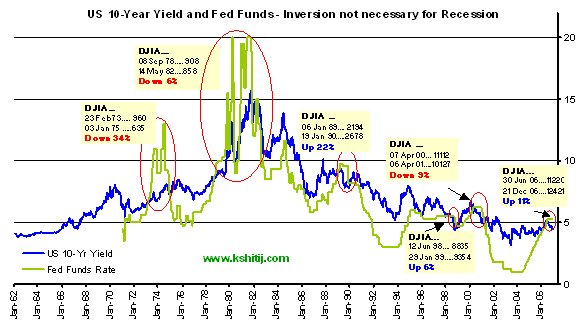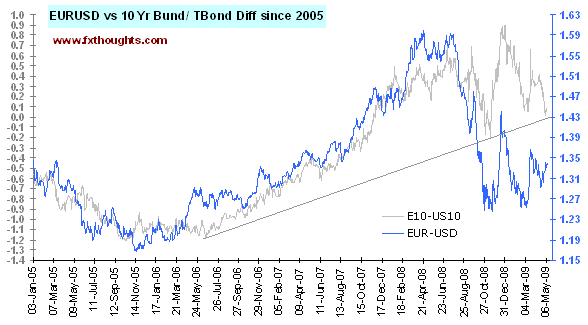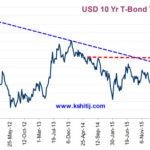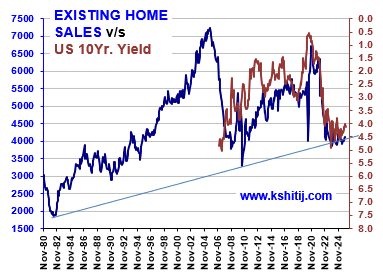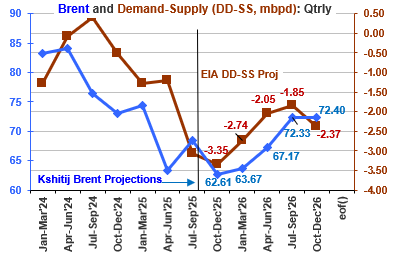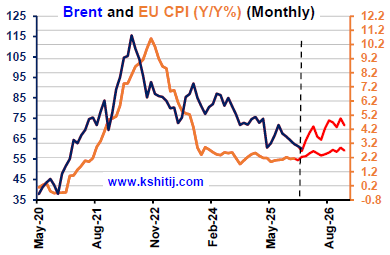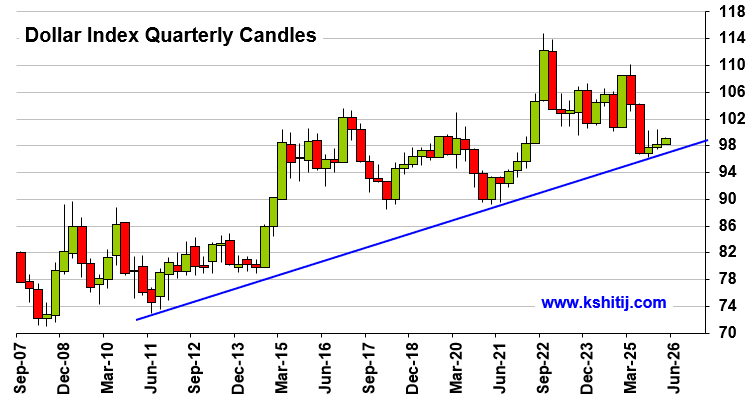BOND YIELD DIFFERENTIALS and EURO-DOLLAR
Jan, 12, 2005 By Vikram Murarka 0 comments

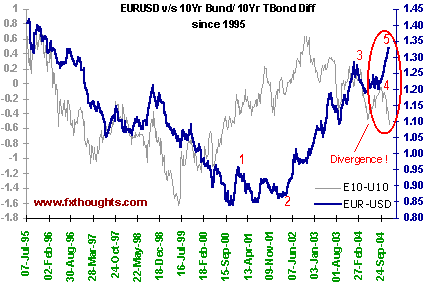
The best long-term investors do not enter into the age old "Fundamentals v/s Technicals" debate. They try and combine both techniques to their advantage. This article focuses on how both Fundamentals and Technicals can be combined in the currency markets and what they are together saying about the Euro-Dollar rate at the moment.
Fundamentals Behind Currency Rates
It is, perhaps, very easy to find the Fundamental drivers for the Equity markets in general and for individual stocks in particular. Market growth, market share, sales, profits, P/E ratios etc. are standard (and very useful) tools in stock-picking. What are the fundamental drivers behind Currency movements? Given that the currency market is most given to Technical Analysis, the Fundamentals are many a times referred to as "Funnymentals".
| Type of Transaction | Share of Daily Volume |
| Speculation | 93.7% |
| Capital Flow related | 4.6% |
| Goods & Services related | 2.1% |
It is, of course, understandable that Technicals should be the technique of choice in the currency market, since a lion's share of the daily turnover of $1.9 trln is speculative. The two major Fundamental drivers in the currency market are Trade flows and Capital flows. Of these, the volume of Capital Flows is bigger than that of Trade Flows and exercise a greater influence on currency rates, as can be seen in the table above.
The following might sound like heresy in the current climate where a weaker Dollar is commonly seen as the cure for the US Trade Deficit, but, since the major part of global trade is actually US Dollar denominated, trade flows have minimal impact on currency rates. Also, the leeway for choosing any currency other than the Dollar as the Invoicing Currency is usually limited. As such, Capital Flows are considered to be the most important fundamental drivers behind long-term currency movements.
Like water flows to reach its lowest level, capital flows to where the Return on Capital is highest. In the currency market, this truism is expanded to "capital flows to where the relative return on capital is highest". Long-term currency investors like to watch the changes or movement in the Differential between the Government Bond Yields of two countries as a means of forecasting currency movements. Investments flow, obviously, to that Bond market whose yields are comparatively higher. As the bond yields in a country continue to rise relative to the bond yields in another country, there is an increased demand for that country's currency, which drives it higher against the other country's currency.
The emphasis here is on long term investing, because it is at epochal market turning points/ trend reversals that fundamentals are at their most potent.
The Bund-Bond Differential vis-a-vis Euro-Dollar
The chart below shows the relation between the yield differential between the 10-Year German Bund (the name for German Government Bonds, which are taken as a proxy for Euroland Bonds because the Eurozone now has a unified Monetary policy) and the 10-Year US Treasury Bond vis-à-vis the Euro-Dollar exchange rate.
 On the Left Hand Axis we track the difference between the Yields on the 10-Year German Bund and the 10-Year US Treasury Bond (the Grey series). On the Right Hand Axis we track the Euro-USD exchange rate (the Blue series). The pre-introduction rates for EUR-USD have been derived from the Dollar-Deutschemark rates converted at the Euro-Deutschemark rate.
On the Left Hand Axis we track the difference between the Yields on the 10-Year German Bund and the 10-Year US Treasury Bond (the Grey series). On the Right Hand Axis we track the Euro-USD exchange rate (the Blue series). The pre-introduction rates for EUR-USD have been derived from the Dollar-Deutschemark rates converted at the Euro-Deutschemark rate.
As can be seen, the Yield Differential, which was 62 bp in the favour of the Bund in July-95, declined to a negative 159 bp by June-99, over roughly four years. During this period the EUR-USD rate fell from 1.4171 to 1.0535. We then encounter a 16-month lag wherein although the Yield Differential rose from -1.59% in June 99 to -0.507% in Nov-00, the Euro continued declining against the Dollar to hit a low of 0.8378 in Nov-00, before embarking on a long-term upmove. From Nov-00 to Nov-02, the two series moved in tandem with the Yield Differential rising from -0.507% to +0.608% and the EUR-USD rate rising from 0.8378 to 1.0098.
The point to be noted is the overall positive correlation between the Yield Differential and the Exchange Rate over a long period of time and that the former is a leading indicator of the latter. You can find a Lead Adjusted version of the above chart at the end of this article, alongwith correlation details.
Skating on Thin Ice?
Cut to the present. As can be seen, the Bund-Bond Differential has again slipped deep into the negative, diving from near -0.05% on 17-Sep-04 to -0.57% 0n 03-Dec-4. This means that the Yield Differential does NOT currently support the Euro, it supports the Dollar. Yet, the Euro has shot up against the Dollar since Sep-04. There is, thus, a stark divergence between the Differential and the Exchange Rate today, suggesting that the Euro lacks a very important Fundamental Support.
If we now bring in the Technicals and impose an Elliot Wave count on the Euro-Dollar chart, it may seem that the Euro could be skating on thin ice.
Lets go over the Wave Count:
Wave 1 started from 0.8378 in Nov-00 and ended near 0.9516 in Jan-01
Wave 2 ended near 0.8708 in Feb-02. Some may even say that Wave 2 ended near 0.8473 in July-01.
Wave 3 ended near 1.2818 in Jan-04
Wave 4 ended near 1.1887 in May-04
We may now be in Final Wave 5 of the big upmove that started from 0.8378 in Nov-00. According to Elliot Wave Theory, the Fifth Wave is usually the most speculative, when all the latecomers join the party, usually after the fundamental drivers of the big trend have changed.
This is so starkly visible in the presented chart, it is almost literally crying for attention. While the Euro may well continue to strengthen in the short term, long-term investors may want to buy some protection against a Euro fall.
Lead Adjusted Chart
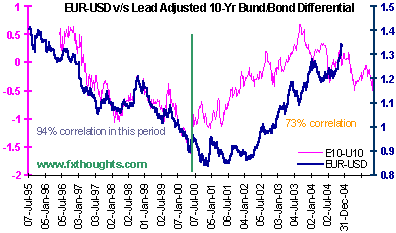 The relation between the Bund-Bond Differential and the USD-DMark rate was very close at 94% till the introduction of the Euro. This can be seen in the chart alongside, where the 12-month Lead Adjusted 10-Yr Bund/ Bond Differential is juxtaposed against the EUR-USD rate.
The relation between the Bund-Bond Differential and the USD-DMark rate was very close at 94% till the introduction of the Euro. This can be seen in the chart alongside, where the 12-month Lead Adjusted 10-Yr Bund/ Bond Differential is juxtaposed against the EUR-USD rate.
The relation between the Bund-Bond Differential and the EUR-USD rate is looser now at 73% because the Euro represents many countries, not just Germany. Yet, this is a high enough correlation to warrant consideration.
Note: This article has also appeared on "http://www.working-money.com under the name "Fundamentals + Technicals together again"
Array
As expected in our last report (09-Dec-25, UST10Yr 4.16%) the US Fed indeed reduced the Fed Rate further by 25bp to 3.75%. We had also said that we expect another …. Read More
Crude prices have been steady and tilted to the downside over the last few months. Hovering near $60, can it gradually move up towards $70? Or could there be room for more fall towards $55/50? … Read More
Brent and EU Inflation has been low in the last few months. If both the EU Inflation and Brent see a gradual rise in 2026, the upside could be …. Read More
In our 04-Dec-25 report (10Yr GOI 6.54%) we conceded that RBI may cut the Repo due to the unexpectedly sharp fall in the Oct-25 CPI to 0.25%. The RBI then indeed … Read More
In our 10-Dec-25 report (USDJPY 156.70), we expected the USDJPY to trade within 154-158 region till Jan’26 before eventually rising in the long run. In line with our view, the pair limited the downside to … Read More
Our January ’26 Dollar Rupee Quarterly Forecast is now available. To order a PAID copy, please click here and take a trial of our service.
- Kshitij Consultancy Services
- Email: info@kshitij.com
- Ph: 00-91-33-24892010
- Mobile: +91 9073942877


